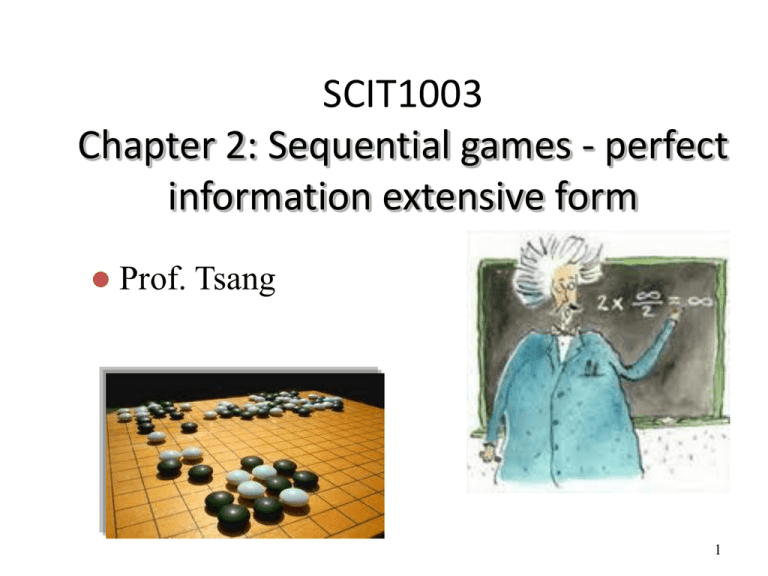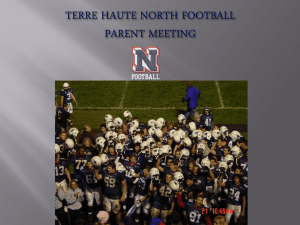SCIT1003 Chapter 2: Sequential games
advertisement

SCIT1003 Chapter 2: Sequential games - perfect information extensive form Prof. Tsang 1 Games of Perfect Information • The information concerning an opponent’s move is well known in advance. Players have perfect information of what has happened every time a decision needs to be made, e.g. chess. • All sequential move games are of this type. • Otherwise, the game is one of imperfect information. 2 2- Person Sequential Game: Simple Nim (Also called the ‘subtraction game’) Rules • Two players take turns removing objects from a single heap or pile of objects. • On each turn, a player must remove exactly one or two objects. • The winner is the one who takes the last object Demonstration: http://education.jlab.org/nim/index.html http://en.wikipedia.org/wiki/Nim 3 Simplified Nim: winning strategy (proof) Lemma: Suppose that Players A and B are playing the Nim subtraction game where at each move a player can remove between 1 and c counters, then a player has a winning strategy if they can play a move that leaves k(c+1) counters. Proof We prove this for Player A (1) Base Case (k=1): Suppose A leaves c+1 counters, then B has to choose to remove x:1≤x≤c. This implies that there are y = c+1-x left, where 1 ≤ y ≤ c. Then A chooses y and wins. 4 Simplified Nim: proof (2) (2) Inductive step: Assume the statement is true for k=n (n≥1). I.e. if Player A leaves n(c+1) , then player A wins. Suppose A leaves (n+1)(c+1) counters left, i.e. nc+n+c+1 If B chooses x:1≤x≤c, this leaves nc+n+c+1-x. Then A chooses c+1-x, leaving n(c+1). (3) Completion of proof by induction: Thus if the case k=n is true, then so is the case k=n+1 We have the base case k=1, is true, so the statement is true for k=2,3,… and so on. The Lemma is thus proved by induction for all values of k. 5 Another Example: 21-flags game p.44 • • • • 21 flags are planted in the field 2 teams (players) Each team moves sequentially and removes 1, 2 or 3 flags each time (0 is not allowed) • The team to take the last flag wins. 6 Game characteristics • Sequential: linear chain of moves • Perfect information • No uncertainty (in probabilistic or strategic sense) • Linear chain of reasoning: if I do this he can does that, then I can respond by … • Study by drawing a game-tree • Game will end at some point (finite game) 7 Thinking forward • At the end, the winning team should leave the other side 4 flags (why?) • What should the winning team do before the end? • … and before that? 8 Thinking forward to the end A -3 (0) -1 (3) B (4) -2 (2) Winner: A -2 (0) -3 (1) -1 (0) 9 Thinking forward to before the end A -3 (4) -1 (7) B (8) -2 (6) Winner: A -2 (4) -3 (5) -1 (4) 10 Reasoning backward • Whoever (A) moves first will win by removing 1 flag, leaving 20 • If B removes 1, A removes 3, leaving 16 • If B removes 2, A removes 2, leaving 16 • If B removes 3, A removes 1, leaving 16 • Next round • If B removes 1, A removes 3, leaving 12 • If B removes 2, A removes 2, leaving 12 • If B removes 3, A removes 1, leaving 12 11 Otherwise • If A removes 3 leaving 18, B removes 2 leaving 16 • If A removes 2 leaving 19, B removes 3 leaving 16 • … • At the end A will lose the game 12 Extensive form: decision/game tree -1 (17) A -2 (16) -1 (20) -1 (18) A (21) -2 (19)B -3 (18) -3 (15) -2 (17) -3 (16) 13 Rule # 1: Backward reasoning (induction) • Think forward • Reason backward Next Example: Truel 14 A truel is like a duel, except that there are three players. Each player has a gun and can either fire, or not fire, his gun at either of the other two players. Each player’s preferences are: Being the lone surviver (best payoff = 4), Survival with another player (the second best = 3), All players survive (the second worst=2), The player’s own death (worst case=1). 15 If they have to make their choice simultaneously, what will they do? Ans. All of them will fire at either one of the other two players. If their choices are made sequentially (A>B>C>A>B>…) and the game will continue until only one player lift, what will they do? (assume the probability to hit on target is 100%) Ans. They will never shoot. 16 17 US Presidential game Every year, the US Congress passes bill to authorize expenditures in different areas. President can sign or veto the bill depends on whether he likes it or not. When the Congress and President are controlled by different parties, there is always a flight over how money should be spent, e.g. on M (missile defense) or U (urban renewal). p.41 18 Which is a better system? • With Line-item veto (proposed by Ronald Reagan in 1980s, the president can select the item he opposes to veto), or • Without Line-item veto (current system, the president just veto the entire bill) 19 Presidential game: without Line item veto p.42 20 Presidential game: with Line item veto p.42 21 Hong Kong Democratic Reform game Demo-parties Accept No reform 0 Gradual Central reform Government One-step reform Reject -1 -1 0 1 0 1 -1 -1 1 -1 -1 22 Summary: Ch. 2 • In study a sequential game, it is useful to analyzing it with a game-tree. • Think forward – examining all possible endgame situations. • Reason backward – to figure out the correct moves (strategy). [backward induction] 23 Discussions • Is there a first mover advantage in sequential game? • Sometimes there is – Give an example • Sometimes there is not – Give an example • Determine whether order matters in the following examples: – Adoption of new technology – Class presentation of a project Assignment 2.1 • Analyze the “Century Mark” game described below and figure out a winning strategy: – 2 players taking turns – At each turn each player chooses an integer between 1 & 10, inclusively, and sum it cumulatively (initial sum = 0) – The first player take the cumulative sum greater than or equal to 100 wins the game. • Is there a first mover advantage in this game? 25 Assignment 2.2 Assignment 2.3






